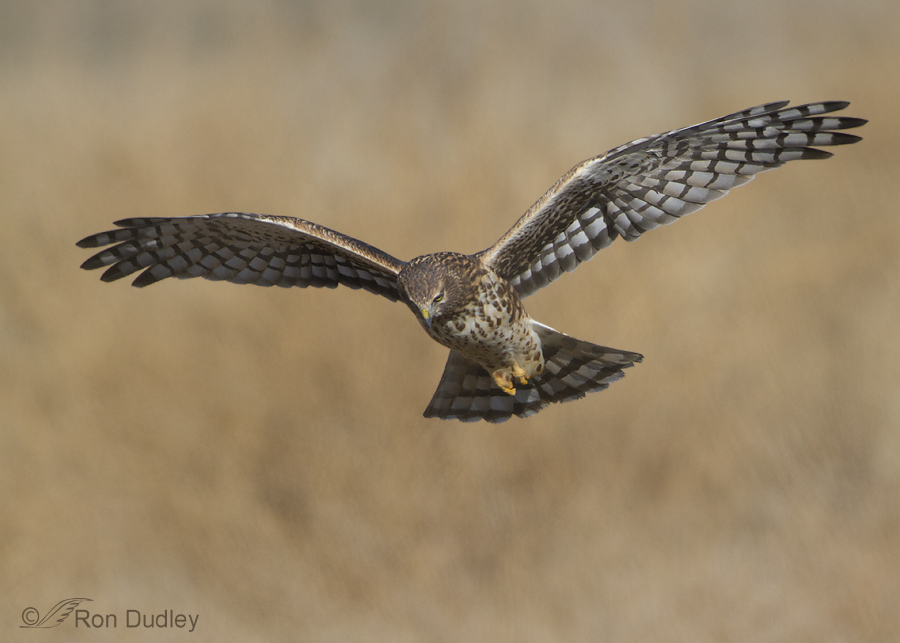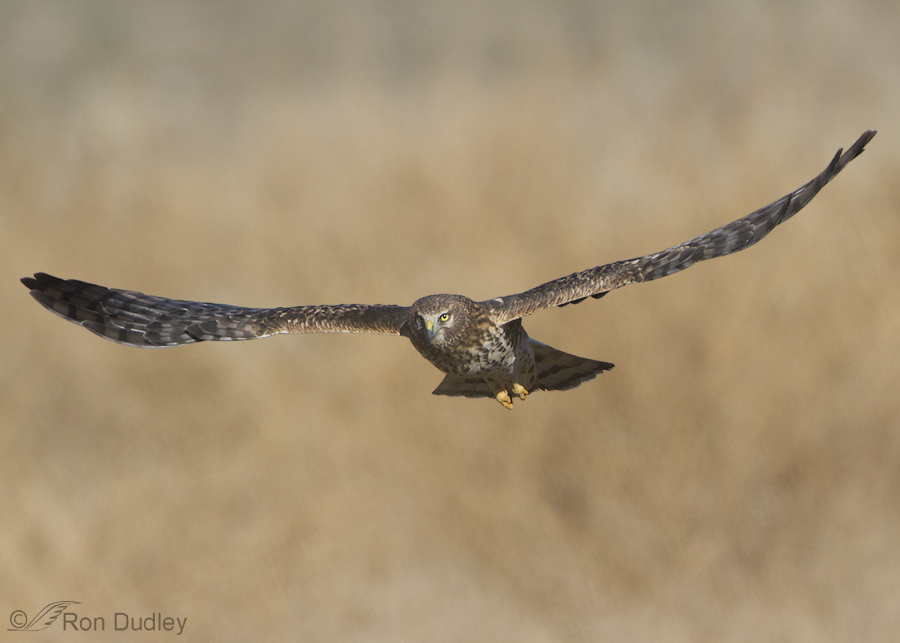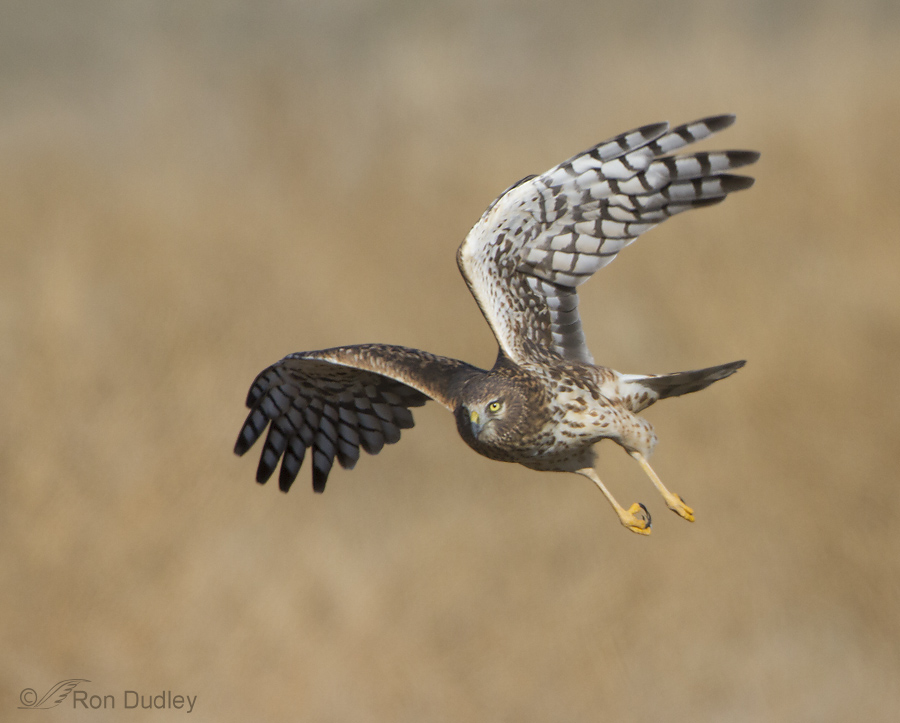Harriers have been a common subject for me over the years so I don’t often notice something new about them.
In full flight most raptors tuck their feet up against the base of their tail (largely to reduce drag, I’m sure) but immediately after take-off their feet and legs are usually still extended below and behind them until they gain airspeed. In flight shots one can usually tell if the bird is in full flight or has just taken off by the position of the feet and legs (everything else being equal, full flight shots are generally much more difficult than take-off shots). In past posts I’ve mentioned that harriers can be an exception to that “rule” – when they’re hunting “low and slow” and very close to the ground they often hang their long legs below their bodies when they’re in full flight but have little airspeed.
But over the last year or so I’ve noticed another situation where harriers momentarily hang their feet low even though they haven’t recently taken off or been hunting low and slow. The following three photos illustrate my point.
1/3200, f/6.3, ISO 500, Canon 7D, 500 f/4, 1.4 tc, not baited, set up or called in
In late November of this year I was watching this harrier hunt the Farmington phrags as it came generally in my direction.
1/3200, f/6.3, ISO 500, Canon 7D, 500 f/4, 1.4 tc, not baited, set up or called in
It was flying at a moderate speed and you’ll notice that in both images its feet are tucked fairly tightly against the body. But as it got closer to me it apparently decided that it was getting too close to that big gray truck with all the clicking noises coming from those two big “eyes” pointing at it through the windows so it…
1/3200, f/6.3, ISO 500, Canon 7D, 500 f/4, 1.4 tc, not baited, set up or called in
put on a burst of speed as it quartered away and as it did so its legs came down. So here’s a harrier in full flight that hasn’t just taken off and isn’t hunting low and slow but its legs and feet are still down. In the distant past I’d likely have interpreted this as a recent take-off shot and I’d have been wrong.
Unlike other hawks, harriers often rely heavily on auditory cues as they hunt (thus their facial disc – absent in other hawks) which is why they’re known for hunting low and slow over the ground. I suspect that other hawks might also drop their legs as they accelerate from an initial near-stall flight speed. It’s just that they don’t do it very often.
I’m far from a raptor expert but I am a bird photographer with a strong interest in behavior and I do my level best to interpret what I observe. It’s possible I’ve gone astray on this one so I’d be very receptive to any other opinions.
Ron





How can anyone not be in love with Northern Harriers, with images like these? A gorgeous bird!
Interesting info and fantastic shots Ron!
Charlotte
Education and delight. Again. Thanks Ron (and commentators).
More interesting observations, Ron! Based on your notes and the comments from Tim, perhaps dropping the legs is in anticipation of an aerodynamic maneuver, such as an airplane adjusting flaps or aileron in order to make a turn? It will be interesting, over time, to see if any of us observe similar actions from raptors which are in full flight and notice if a specific maneuver occurs in conjunction with the leg drop.
Super photos of that beautiful bird!
The few harriers I’ve been lucky enough to see, made quick sharp turns as well as log, low sweeps…do you think those slightly lowered feet might serve as the keel or rudder on a boat? Wonderful images of a solid, healthy looking bird… especially like the first, scoping the ground for an unfortunate vole “slider”…?
In what I call “dynamic flight” (yah, I made it up, lol) anything other than soaring triggers a counter weight type move. Wing Overs, defensive moves, stoops and of course landing. I can tell if Sakura is going to make a sudden change in direction just by way she turns her head and lets her talons out. Hawks/falcons have joints that lock when they grab a hold of something, so I often feel her MO is to stretch her toes before something “big” is about to happen. She then will let her legs droop, hang a little, even kick before the next move. And of course these are things I see with my Hawk, which I spend a great deal of time with. Hawks can be indivuals as much as the next species.
Ron, I love these shots. I’m starting to think you have some great karma with the Harriers. Awesome stuff!
Tim
Great images, Ron! I wonder if this isn’t the bird doing some type of mid-air counter balancing as it changes direction of travel. Like a cat falling in the air will flail its tail around to correct its position to land on its feet, this might be some sort of counter move by the bird to keep its orientation correct so that while changing direction it can still keep its eye on a target. Just a guess…
Thanks, Steve. In this case you could very well be right since the bird was in the beginning of a moderate turn.
Great images Ron! I think your analysis is right on the money. Watch a Red -tail or any other raptor take off from their perch and I think you would witness the same thing.
Tim
Tim, You’re right, of course – other hawks hang their feet low right after take-off before they’ve gained much airspeed. But it’s my impression that most hawks don’t assume this posture often in full flight like harriers do.
How do you get so close? Are you in a blind? Does camouflage clothing and lens coverings help? Are you waking or n a car? Do you walk with light specifically at you back and side? Is there a place where I can get more information?
Mark, I’m nearly always shooting from my pickup, as I was here. Vehicles make great blinds. If I’d been on foot the bird would very likely have not come in this close. I don’t use camo (except for the Lenscoat on my lens, which is primarily used for protection of the lens). I always drive with the goal to get the sun behind me as I shoot but harriers are notorious for not cooperating with light angle.
… or maybe that you had something for him to eat … ??
Thank you, Lois. I’m pretty sure that the leg position was neither a defensive posture or in anticipation of food. IMO it’s a mechanical (muscles and bones) posture of raptors as they accelerate from very low speeds.
… maybe he was worried that the big gray truck and its clicking noises were a threat … and he was readying his arsenal of defense mechanisms (his feet) … just in case?? GREAT images, as always!!!! Just a joy to view, Ron!!